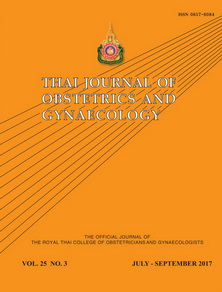Risk Factors for Cesarean Hysterectomy at Maharat Nakhon Ratchasima Hospital
Main Article Content
Abstract
Objectives: To evaluate incidence, risk factors and complications of cesarean hysterectomy
Materials and Methods: This was a retrospective case-control study. The study cases included 80 pregnant women with cesarean hysterectomy at Maharat Nakhon Ratchasima Hospital from January 1st, 2010 to December 31st, 2015. The controls referred to 320 pregnant women who underwent cesarean section at the closest time before and after the study cases. The medical records were collected and analyzed. Multivariate logistic regression analysis was performed to identify risk factors.
Results: During the study period, there were 50,729 deliveries and 80 pregnant women with cesarean hysterectomy (1.58:1,000). The statistically significant risk factors for cesarean hysterectomy were placenta adherent (adjusted odds ratios (AOR) 120.91, 95% confidence interval (95% CI 22.05-1653.22), uterine atony (AOR 26.77, 95% CI 5.64-127.07), placenta previa (AOR 19.15, 95% CI 5.74-63.92), the tearing of lower uterine segment (AOR 14.92, 95% CI 4.92-45.29), multigravida (AOR 4.84, 95% CI 1.65-14.20) and emergency cesarean section (AOR 3.98, 95% CI 1.26-12.58). Hypovolemia, disseminated intravascular coagulation, postoperative fever and bladder injury were significant common complications.
Conclusion: Placenta adherent, uterine atony, placenta previa, the tearing of lower uterine segment, multigravida and emergency cesarean section were identified as significant risk factors for cesarean hysterectomy.
Article Details
References
2. Hamilton BE, Martin JA, Ventura SJ. Births: Preliminary Data for 2013. Natl Vital Stat Rep 2014;63:1-19.
3. Festin MR, Laopaiboon M, Pattanittum P, Ewens MR, Henderson-Smart DJ, Crowther CA. Caesarean section in four South East Asian countries: reasons for, rates, associated care practices and health outcomes. BMC Pregnancy Childbirth 2009;9:17.
4. Gibbons L , Belizán JM , Lauer JA , Betrán AP, Merialdi M, Althabe F. The Global Numbers and Costs of Additionally Needed and Unnecessary Caesarean Sections Performed per Year: Overuse as a Barrier to Universal Coverage. World Health Report 2010 Background Paper, No 30.Geneva: WHO; 2010.
5. Silver RM, Landon MB, Rouse DJ, Leveno KJ, Spong CY, Thom EA, et al. Maternal morbidity associated with multiple repeat cesarean deliveries. Obstet Gynecol 2006;107:1226-32.
6. Say L, Chou D, Gemmill A, Tunçalp Ö, Moller AB, Daniels J, et al. Global causes of maternal death: a WHO systematic analysis. Lancet Glob Health 2014;2:e323-33.
7. Watanasomsiri N, Rungruxsirivorn T, Chaithongwongwatthana S. Risk factors for cesarean hysterectomy in cesarean delivery. J Med Assoc Thai 2006;89:S100-4.
8. Yamasmit W, Chaithongwongwatthana S. Risk factors for cesarean hysterectomy in tertiary center in Thailand: a case-control study. J Obstet Gynaecol Res 2009;35:60-5.
9. Shellhaas CS, Gilbert S, Landon MB, Varner MW, Leveno KJ, Hauth JC, et al. The frequency and complication rates of hysterectomy accompanying cesarean delivery. Obstet Gynecol 2009;114:224-9.
10. Bodelon C, Bernabe-Ortiz A, Schiff MA, Reed SD. Factors associated with peripartum hysterectomy. Obstet Gynecol 2009;114:115-23.
11. Rong J, Yuna G, Yan C. Risk factors associated with emergency peripartum hysterectomy. Chin Med J (Engl) 2014;127:900-4.
12. Chanterm T, Chittacharoen A, Israngura Na AyudhyaN. Risk factors of emergency peripartum hysterectomy. Thai J Obstet Gynaecol 2015;23:96-103.
13. Semachai S. Emergency postpartum hysterectomy in Maharat Nakhon Ratchasima Hospital: clinical characteristic and risk factor. Med J Srisaket Surin Buriram Hospitals 2010;25:293-305.
14. Selo-Ojeme DO, Bhattacharjee P, Izuwa-Njoku NF, Kadir RA. Emergencyperipartum hysterectomy in a tertiary London hospital. Arch Gynecol Obstet 2005;271:154-9.
15. Wingprawat S, Chittacharoen A, Suthutvoravut S. Risk factors for emergency peripartum cesarean hysterectomy. Int J Gynaecol Obstet 2005;90:136-7.
16. Macharey G, Ulander VM, Kostev K, Väisänen-Tommiska M, Ziller V. Emergency peripartum hysterectomy and risk factors by mode of delivery and obstetric history: a 10-year review from Helsinki University Central Hospital. J Perinat Med 2015;43:721-8.
17. D’Arpe S, Franceschetti S, Corosu R, Palaia I, Di Donato V, Perniola G, et al. Emergency peripartum hysterectomy in a tertiary teaching hospital: a 14-year review. Arch Gynecol Obstet 2015;291:841-7.
18. American College of Obstetricians and Gynecologists. ACOG Practice Bulletin: Clinical Management Guidelines for Obstetrician-Gynecologists Number 76, October 2006: postpartum hemorrhage. Obstet Gynecol 2006;108:1039-47.
19. Satapornteera P, Arj-Ong S, Aswakul O. Factors associated with early postpartum hemorrhage of singleton pregnancy in Maharat Nakhon Ratchasima Hospital. Thai J Obstet Gynaecol 2012;20:21-28
20. World Health Organization. WHO recommendations for the prevention and treatment of postpartum haemorrhage. Geneva: WHO; 2012.
21. Imudia AN, Awonuga AO, Dbouk T, Kumar S, Cordoba MI, Diamond MP, et al. Incidence, trends, trends, risk factors, indications for, and complications associated with cesarean hysterectomy : a 17-year experience from a single institution. Arch Gynecol Obstet 2009;280:619-23.
22. Awan N, Bennett MJ, Walters WA. Emergency peripartum hysterectomy: a 10-year review at the Royal Hospital for Women, Sydney. Aust N Z J Obstet Gynaecol 2011;51:210-5.

